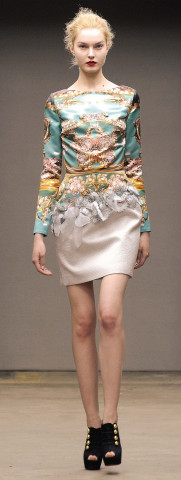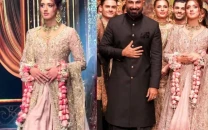Digitalised designs
Katrantzou’s creates dresses that are wearable, a tactic Pakistan's couture houses could learn from.

One only has to glance inside a Zara store to know that this trend has filtered down to the masses. However one bold young designer refused to conform to the minimalist chic that featured throughout the autumn/winter collections of so many well-established brands. Mary Katrantzou, who is considered one of the rising stars on the London fashion scene, broke away from this season’s supposedly ‘must-have’ trend, instead wowing us with a myriad of digital print dresses infused with eye-popping flashes of colour. Since launching her eponymous line back in 2008, her designs have been worn by a slew of celebrities, which is why her first stand-alone show was one of the hottest tickets in town this fashion week.
From her MA graduate collection to her work today, it is safe to say that Mary Katrantzou has a very distinctive signature style that sets her apart from the hundreds of other aspiring designers churned out by fashion colleges each year. Her graduate collection was themed around trompe l’oeil. She was heavily influenced by Russian Constructivism and early 1970s movie posters and each dress was brought to life by vivid digital prints of oversized jewellery. These pieces created the illusion of wearing giant neckpieces that would be too heavy in reality.
Her exquisite use of digital prints is her trademark. However, that is not to say that her collections have ever been in danger of becoming dull or repetitive. For previous seasons, the prints with which she adorned her dresses have been inspired by oversized jewellery, perfume bottles and artisan blown glass. This winter, Katrantzou turns back the clock even further and draws inspiration from 18th century society paintings. The clean, sharp edges of her earlier work have been replaced by a softer portraiture affect, giving her pieces a striking yet deliciously feminine look. She plays with the idea of transferring the image of attire worn by the women and men of the Regency period onto the body of a 21st century woman.
Her pieces are works of art, but at the same time she manages to create dresses that are totally wearable, which is a tactic Pakistan’s couture houses could do well to learn from.
In conversation with Mary Katrantzou
In just two years, you’ve gone from fresh graduate to sought-after designer. What would your advice be to fashion design students in the UK?
It seems unreal that it’s only been two years since I launched my label. I think it is important to stand by your work and know how to develop it ... know what is unique about it and be focused. London is the best place to start your business; you have a great platform and support system. Sometimes it happens early on; otherwise it’s best to first work in the industry and get valuable experience.
Does it help or harm the brand to have celebrities wear your designs?
It depends on how you want to develop your brand. When I first saw who wore my designs, it helped me understand who I wanted to be as a designer. You can decide to be a designer who dresses celebrities, which brings huge awareness to your brand and can open up new markets. I still like it when women with great presence wear my clothes. Anna Dello Russo (Fashion director for Japanese Vogue) wore my Spring/Summer 2011 lampshade skirt, straight off the catwalk during Paris Fashion Week. She really made it her own and looked great. It needs to be the right match; it’s not about seeing it on any celebrity. They bring life to your vision, so it has to be right.
Digital prints have caught on in a big way - do you feel it may be becoming oversaturated? Since it is your signature, how do you see it evolving?
I think it was a necessary evolution from screen-printing. If not for the digital print revolution, I would never be able to do what I do! Digital print gives the opportunity to designers to create a very distinctive visual language. You can take it into so many different directions. It is not about a generic floral that you can get tired of; there is still a lot of room for designers to explore and find new ways of using it.
Your show was funded by a British Fashion Council (BFC) initiative. How do you see the evolution of the council, especially in putting London Fashion Week back on the map?
I think there has been a newfound interest in British designers in the past five to six years and international buyers and the press are taking note. The BFC has advanced its mentorship program and you get a good understanding of the industry through their seminars. I joined them when they first set up the Showroom in Paris, which meant that I could do sales without paying an agent a commission. It meant growing my distribution to over 70 stores worldwide in two years, so I’m really grateful to be given this platform. It was a very important decision to appoint Sarah Mower, as ambassador of emerging talent. She really knows the industry and has been a great mentor.
You’ve also worked with Topshop - how key do you think the retailer-high end designer collaboration is in today’s fashion environment?
It’s pivotal and it helped me have a better grasp of a market I didn’t know that much about. It is rewarding to see your designs reach a different market than your main line. It felt great when I was walking down Oxford Street and saw three girls wearing the range I designed for Topshop. It made it affordable to younger girls who might not have been able to buy one of my main collection pieces.
Iman Pasha is a London-based fashion consultant and fashion journalist. Her website is www.imanpasha.com
Published in The Express Tribune October 31st, 2010.



















COMMENTS
Comments are moderated and generally will be posted if they are on-topic and not abusive.
For more information, please see our Comments FAQ